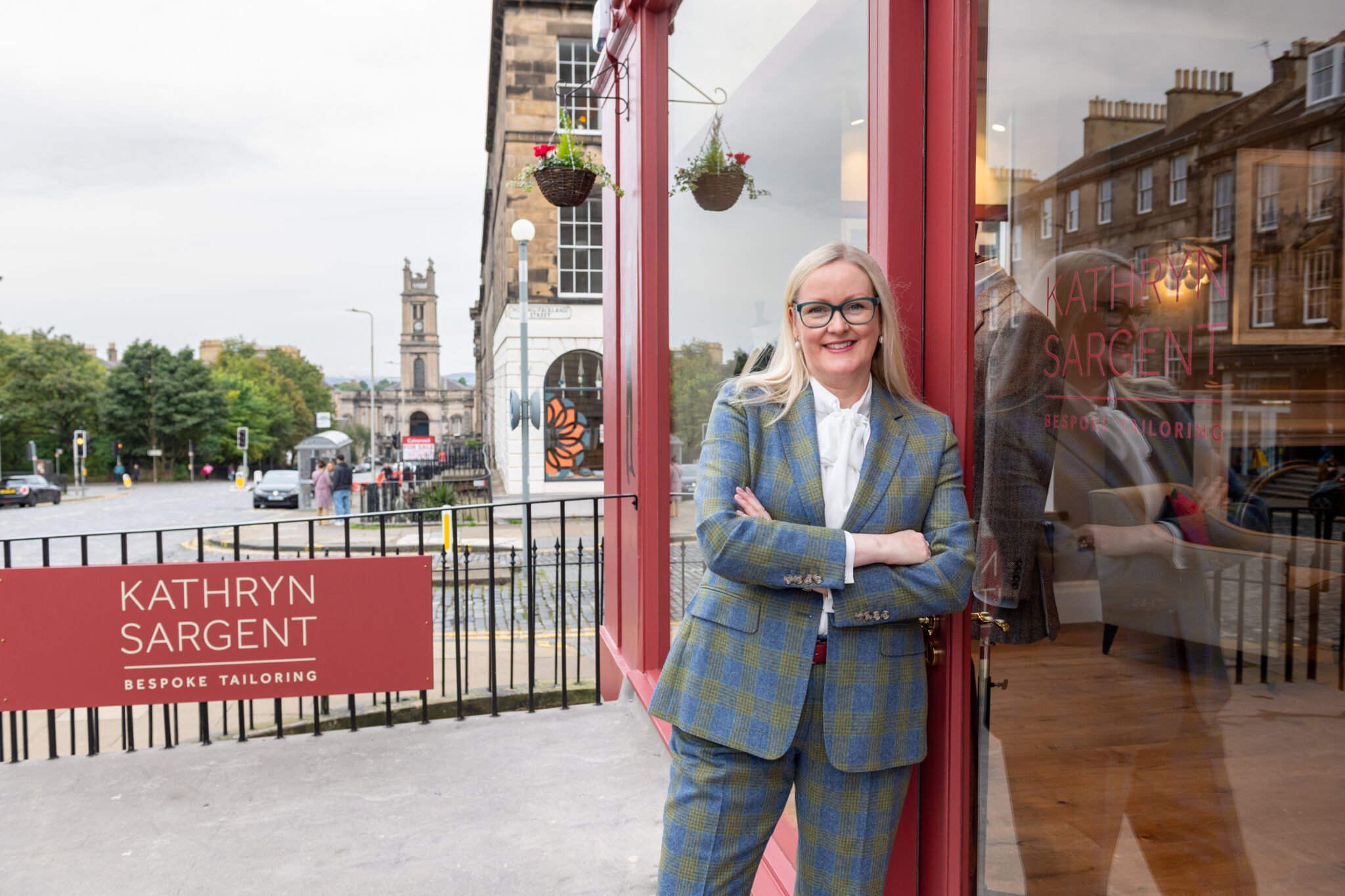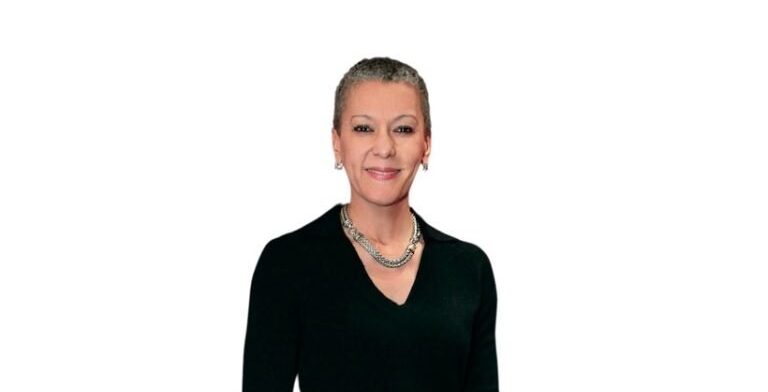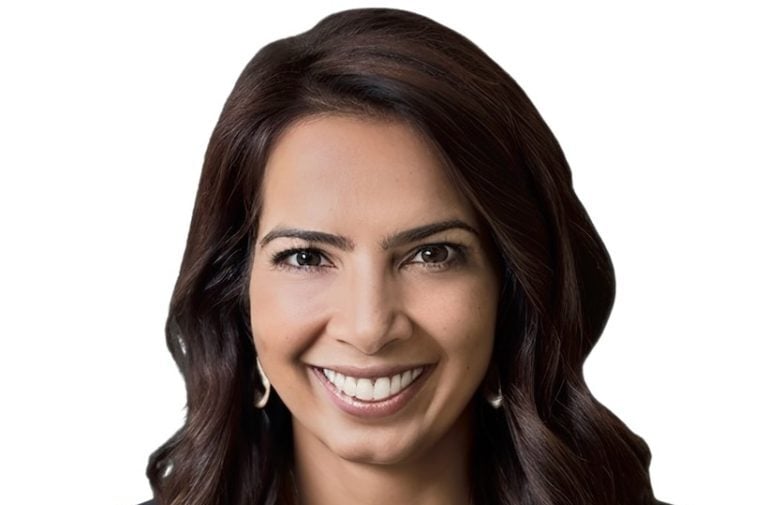When one thinks of Savile Row in London, the first image that comes to mind likely consists of an intimate shop, run by a cadre of smartly dressed, well-trained men who expertly craft custom garments for a high-profile male clientele. Considering the bespoke industry’s history, it is not surprising that this scene is perhaps the most ubiquitous when it comes to British tailoring. Since the 18th century, male politicians, musicians, royalty, and socialites have flocked to Savile Row to procure made-to-measure pieces from shops helmed by male cutters. Napoleon III, Winston Churchill, Mick Jagger, Elton John, and Prince Harry are just a few of the dozens of notable men to frequent London’s famed tailoring shops.
However, in 2016, Kathryn Sargent made a move to change that male-dominated image when she became the first and only female Master Tailor to open her own shop on Savile Row. Prior to this, Sargent had already established herself as a force to be reckoned with in the bespoke field. With over two decades of experience, she became the first woman to reach the post of Head Cutter in Savile Row history at Gieves & Hawkes, one of the street’s oldest houses.

Now, not content with just running her Savile Row shop, Sargent is taking her incomparable skillset and unique take on custom clothing craftsmanship to Edinburgh. With a new shop on Howe Street, run alongside Scottish-born Head Cutter Alistair Nimmo, she is not only expanding the scope of her clientele but also her relationship with the traditions of British tailoring.
For instance, as with the London Atelier, Sargent’s customers will be able to order suits, coats, dresses, and skirts. However, customary Scottish garments, including trews, kilts, and capes will now also be on offer. Further, since the advent of her business, Sargent has always offered a Kathryn Sargent Harris Tweed, specially woven in the Outer Hebrides, off the west coast of Scotland. To celebrate the opening of the new atelier in Edinburgh two new colorways of her signature Harris Tweed designs in green and blue have been added to the shop’s repertoire, in addition to a broad selection of tartans. Simply put, Sargent’s Edinburgh location aims to blend traditional Scottish textiles and dress with her unique take on British tailoring to create a sustainable bespoke experience for a new city.
We recently sat down with Sargent to hear more about her experience climbing to the top of the male-dominated Savile Row, as well as what she hopes to bring to Scotland’s capital with her new shop.
Powless: As Savile Row’s first female Master Tailor to have their own shop, what has your experience been like rising to the top of this male-dominated industry? Throughout your ascendance, were there times that you were made aware of your gender and, if so, how exactly did those instances materialize?

Kathryn Sargent: When I started in this industry, there were very few women in roles that were client-facing. There were always women in the industry, but behind the scenes. It’s a very unusual industry because we have to deal with customers, and we always have to be available. It’s just a very hard industry to be in as a woman. However, I have always been encouraged. I have always been interested in cutting and the customer, and delivering lovely products and a great service. My ambition was not to be behind the scenes, but to be in front. I didn’t want to change the world or anything, but I really wanted to do this. It definitely took people a bit by surprise, but I’ve had great support from the men in the industry who have similar roles. For me, I didn’t think of myself as a woman, I thought of myself as a tailor. There are some really fabulous women in the industry, but just not many who have gone out and set up their own businesses. There are a couple more now, but back when I started mine 11 years ago, it was the first time when a Master Tailor was a woman in this world. It was quite unusual, I suppose.
When I was a young cutter back at Gieves & Hawkes and I was training, that’s when I. started seeing customers and started managing the process myself. There was a little bit of resistance from a couple of customers. There was one lady, actually, who refused to see me and said that I shouldn’t be doing that job. It was an interesting experience and I didn’t expect it to come from a woman. And there was one gentleman who also refused to see me, but. That was two people in 15 years. Now, I think people will come to my business because they want to meet me and want to work with me. I’m not hiding in the shadows, but I’m making a bold statement that women can do this equally as well as men. I have encountered resistance, but only surprise when I meet people.
Savile Row is and has historically been a bastion for a male-dominated clientele and many houses still only advertise themselves as hubs for men’s tailoring. Over the course of your tenure on Savile Row, have you seen an expansion of the craft to cover women’s or, rather, gender-less tailoring at all?
There are more and more women who are looking for quality tailoring and are seeking out the skills of a tailor to have something made. Tailoring has been incredibly fashionable in recent years. Especially in the post-pandemic world women are dressing up more. Most of my customers are still predominantly male, but the reason I set up my business was because I saw that there was an opportunity to cater to and make things for women. I was trained at No.1 Saville Row and, historically, Saville Row has been male-dominated in terms of its client base. But, women now are in roles that they probably once couldn’t have even dreamed of being in and they need clothes for that. And where do you go for those? Not every brand or designer caters to different body shapes or different requirements in terms of how a garment performs. There’s a huge opportunity for women’s tailoring at the moment and I wanted to set up my business to make for everybody. We make for all genders. Just understanding the individual and their needs, and problem solving for them is something that excites me.
As mentioned, you are currently the only female Master Tailor on Savile Row, and indeed in its history. Do you see Savile Row and the rest of the bespoke industry more broadly taking steps to even this gender imbalance?
There are definitely more women in the industry than when I started, and I think all of the businesses are actively recruiting women. Basically, we just want to keep the talent pool growing and pass our skills on to the next generation. It should be less of an issue, really. Each company has their own policies, of course, but I have loads of female colleagues who are in training now. Some are cutters and some are tailors. I’ve recruited several women for my own business, which I’m definitely very proud of.
You are now expanding your business and bringing your skillset to Edinburgh with a formal physical location. From your perspective, how do the Scottish tailoring industry and Scottish tailoring practices distinguish themselves from their English counterparts?
For me, it’s all about the textiles, the ingredients that go into the tailoring. A lot of my materials come from Scotland. I love Harris tweed, Shetland tweed, and tartan. I love all of these amazing cloths that are produced in Scotland. I also love the style. People dress up for different occasions and, since it’s a lot colder there, people tend to layer up and wear more tweeds and coats. I just thought, there is a tailoring industry there and there are tailors based in Scotland, but I just want to bring something different. I want to use the inspiration of these beautiful Scottish textiles and present them in my own way. I’m from Yorkshire in the north of England, so I’ve had that influence of Harris tweed throughout my whole career. So, it was important for me to have my own Harris tweed, which I’ve designed and had since I started my business. There are now new colorways, which are available in Edinburgh. But I do think it’s an interesting industry. There are a lot of people making traditional Scottish dress, which we will do, but I wanted to just bring my craft there and showcase it in a different way.
Finally, what are you hoping to bring to Edinburgh’s bespoke scene with your shop? Conversely, are there any new practices or traditions that you’re looking to explore there or bring back to your clientele in England and across the world?
Scotland is such a source of inspiration for me and having a presence there is heartwarming. I’ve designed a range of accessories and ready-to-wear pieces made in our tweed, and we’re planning to do all sorts of exciting things with the Edinburgh shop. Of course, it will all be inspired by Scottish styles and textiles. For example, there will be a lot of amazing evening wear and our take on country attire. It’s an opportunity to delve into the traditional designs and then present our take on them. We have an atelier there so we can manage the whole process there and Alistair, who I trained in London, is Scottish and is heading up the Edinburgh business. He’s able to give great advice on tartans, tweeds, and style. I think that is a point of difference because we have that expert knowledge there. Ultimately, I just want to provide our customers with something different.














